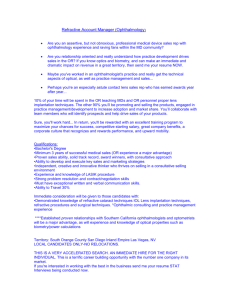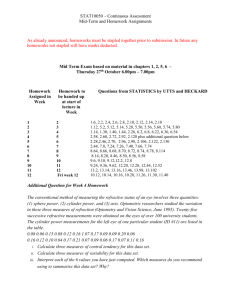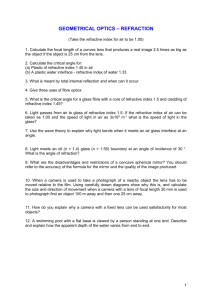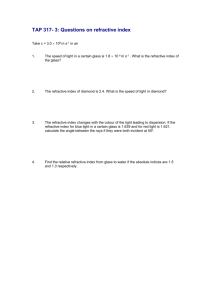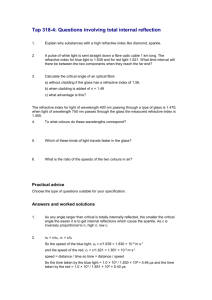DOC
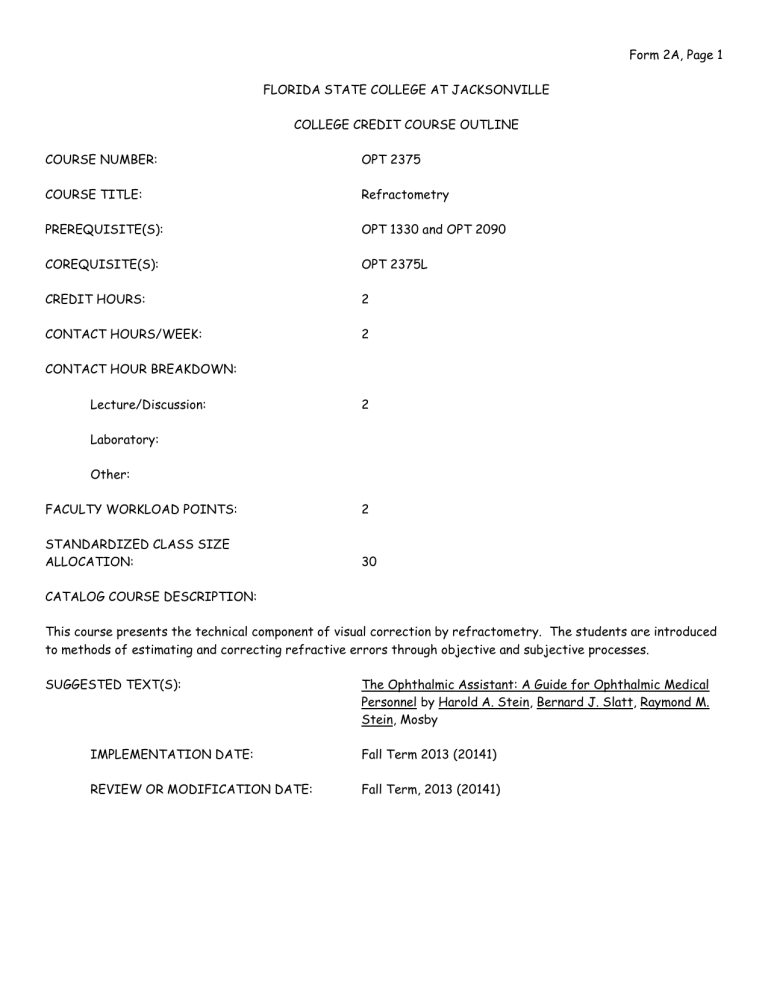
Form 2A, Page 1
COURSE NUMBER:
COURSE TITLE:
PREREQUISITE(S):
COREQUISITE(S):
CREDIT HOURS:
CONTACT HOURS/WEEK:
CONTACT HOUR BREAKDOWN:
Lecture/Discussion:
Laboratory:
Other:
FLORIDA STATE COLLEGE AT JACKSONVILLE
COLLEGE CREDIT COURSE OUTLINE
OPT 2375
Refractometry
OPT 1330 and OPT 2090
OPT 2375L
2
2
2
FACULTY WORKLOAD POINTS:
STANDARDIZED CLASS SIZE
ALLOCATION:
2
REVIEW OR MODIFICATION DATE:
30
CATALOG COURSE DESCRIPTION:
This course presents the technical component of visual correction by refractometry. The students are introduced to methods of estimating and correcting refractive errors through objective and subjective processes.
SUGGESTED TEXT(S):
IMPLEMENTATION DATE:
The Ophthalmic Assistant: A Guide for Ophthalmic Medical
Personnel by Harold A. Stein, Bernard J. Slatt, Raymond M.
Stein, Mosby
Fall Term 2013 (20141)
Fall Term, 2013 (20141)
I.
COURSE TOPICS
Optics of Refraction
II.
Refractive Structures of the Human Eye
III.
Accommodation
IV.
Spherical Refractive Errors
V.
Astigmatic Refractive Errors
VI.
Retinoscopy
VII.
The Phoropter
VIII.
Subjective Refractometry
IX.
Refining the Sphere
X.
Refining the Cylinder
XI.
Balancing
XII. Nar Vision Correction
XII.
Advanced Refractometry Cases
Advanced Refractometry Cases
XIII.
Managing Refractive Complaints
Form 2A, Page 2
CONTACT
HOURS PER TOPIC
2
2
2
2
2
2
2
2
2
2
2
2
4
2
30
Form 2A, Page 3
PROGRAM TITLE:
COURSE TITLE:
Ophthalmic Technician
Refractometry
CIP NUMBER:
Florida Department of Education
Student Performance Standards
1351180301
08.0
Demonstrate an understanding of information technology applications in healthcare–The student will be able to:
08.01
Describe technology applications in healthcare.
08.02
Define terms and demonstrate basic computer skills.
08.03
Recognize technology applications in healthcare.
08.04
Interpret information from electronic medical documents.
08.05
Identify methods of communication to access and distribute data such as fax, e-mail and internet.
11.0
Apply basic math and science skills–The student will be able to:
11.01
Draw, read, and report on graphs, charts and tables.
11.02
Measure time, temperature, distance, capacity, and mass/weight.
11.03
Make, use and convert using both traditional and metric units.
11.04
Make estimations and approximations and judge the reasonableness of the result.
11.05
Convert from regular to 24 hour time.
11.06
Demonstrate ability to evaluate and draw conclusions.
11.07
Organize and communicate the results obtained by observation and experimentation.
11.08
Ask appropriate scientific questions and recognize what is involved in experimental approaches to the solution of such questions.
Calculate ratios.
14.0
Demonstrate anatomical and functional ocular measurements–The student will be able to:
14.01
Describe the principles of human physiology.
14.02
Identify and describe tissues and cellular structures of the eye.
14.03
Apply the correct medical terminology to body structures and functions of the eye.
14.04
Identify cause and effect of the most common pathological conditions of each body system as they relate to the eye.
15.0
Demonstrate testing of ocular functions (including visual acuity and visual fields)–The student will be able to:
15.01
Describe the interaction of light, lenses, laws of optics.
15.02
Describe optical properties of the human eye.
15.03
Measure objectively and subjectively the refractive state of the eye.
Student Performance Standards
CoA-omp Accreditation Standards
1.2
1.3
1.4
1.5
1.6
1.7
1.8
Course Overview:
Optics of Refraction
Course Outcome:
1.0 The student will review the basic theories of light and optics and how they apply to the human visual system
Specific Learning Objectives:
Upon completion of this unit, the student will be able to:
1.1
Define light and discuss its importance to vision
1.2 Describe the wavelength range of ultraviolet radiation, the visible spectrum and infrared radiation and the effect of the wavelength on the human eye
List the three type of ultraviolet radiation and discuss how each effects the human eye
Illustrate where red, blue and yellow light are focused relative to the retina in the human eye
Define and illustrate the refraction of a light ray
Diagram the light rays as they pass through a concave and convex lens
Document the image placement as light is refracted through a concave and a convex lens
Define and illustrate the refraction of a light ray
Diagram the light rays as they pass through a concave and convex lens, and document the image placement
Course Overview:
Refractive Structures of the Human Eye
Course Outcome:
2.0
The student will review ocular anatomy, with special emphasis on the refractive structures of the human eye
Specific Learning Objectives:
Upon completion of this unit, the student will be able to:
2.1
Identify the structures of the human eye
2.2
2.3
2.4
2.5
List the refractive structures of the eye
Discuss the role of the cornea in the location of the focal point
Discuss how the axial length of the eye affects the location of the focal point
List axial length and corneal curvature combinations and their resulting focal point
Course Overview:
Accommodation
Course Outcome:
3.0 This unit will discuss the process of accommodation of the crystalline lens, and the role of accommodation in refractometry
Specific Learning Objectives:
Upon completion of this unit, the student will be able to:
3.1 Describe the process of accommodation
3.2
3.3
List accommodative stimuli
Discuss the synkinetic triad
3.4
3.5
3.6
Describe accommodative ability in children
Discuss loss of accommodation with age
Discuss the use of cyloplegia in refractometry
Course Overview:
Spherical Refractive Errors
Course Outcome:
4.0 The student will identify hyperopic and myopic spherical refractive errors, discuss the image formation of the uncorrected eye, and explain the refractive correction of each refractive error.
Specific Learning Objectives:
Upon completion of this unit, the student will be able to:
4.1
Define the far point of vision
4.2
4.3
Describe the far point and visual perception of a myopic eye
Describe the far point and visual perception of a hyperopic eye
4.4
4.5
Discuss lenses used to correct myopia
Discuss lenses used to correct hyperopia
5.1
5.2
5.3
5.4
5.5
5.6
5.7
Course Overview:
Astigmatic Refractive Errors
Course Outcome:
5.0 The student will identify and compare types of astigmatism and the correction of this refractive error
Specific Learning Objectives:
Upon completion of this unit, the student will be able to:
Compare and contrast regular and irregular astigmatism
List the types of regular astigmatism that affect the human visual system
Determine what type of lens is required to correct the various forms of astigmatism
Describe the Conoid of Sturm
Discuss blur circles and the circle of least confusion
Describe the spherical equivalent of an astigmatic correction
Calculate the spherical equivalent of a given spherocylinder lens
Course Overview:
Estimation of Refractive Status
Course Outcome:
6.0 The student will be able to predict the type of refractive error of a patient, and estimate the required correction for optimal visual acuity
Specific Learning Objectives:
Upon completion of this unit, the student will be able to:
6.1 List methods of estimating the refractive error of a patient’s eye
6.2
6.3
6.4
6.5
Predict the dioptric power of a refractive error from the distance acuity
Predict the type of refractive error by comparison of distance and near acuity
Discuss automated refractors in estimating a refractive error
Estimate the amount and axis of astigmatism from keratometry readings
Course Overview:
Retinoscopy
Course Outcome:
7.0 The student will describe the process of retinoscopy in estimating a refractive error
Specific Learning Objectives:
Upon completion of this unit, the student will be able to:
7.1 Explain the optics of the retinoscope
7.2 List the uses of the retinoscope
7.3
7.4
7.5
7.6
Differentiate between streak and spot retinoscopy
Differentiate between static and dynamic retinoscopy
Describe with motion
Describe against motion
7.7
7.8
Discuss the neutral point and dead zone
List methods of determining the neutral point
7.9
Describe the reflexes of an astigmatic refractive error
7.10
Discuss neutralization of an astigmatic refractive error
7.11
Describe the working distance
7.12
Differentiate between gross and net retinoscopy
7.13
Differentiate between dry and wet retinoscopy
Course Overview:
The Phoropter
Course Outcome:
8.0 This unit will introduce the phoropter in the refinement of a refractive correction
Specific Learning Objectives:
Upon completion of this unit, the student will be able to:
8.1 List the components of the phoropter
8.2
8.3
Differentiate between the plus and minus cylinder phoropter
Discuss proper care and cleaning of the phoropter
8.4 Describe patient positioning at the phoropter
Course Overview:
Subjective Refractometry
Course Outcome:
9.0 This unit will introduce the components of the subjective refractometry process
Specific Learning Objectives:
Upon completion of this unit, the student will be able to:
9.1 Discuss the steps in obtaining a spherocylinder lens combination
9.2 List methods of balancing
9.3 Describe near vision correction
Course Overview:
Refining the Sphere
Course Outcome:
10.0 The student will be able to discuss subjective refinement of the spherical portion of a spectacle lens correction
Specific Learning Objectives:
Upon completion of this unit, the student will be able to:
10.1
Describe the process of presenting lens choices to the patient
10.2
Discuss methods to obtain theoptimal spherical correction
10.3
Describe the process of determining the least minus, most plus sphere power that provides best visual acuity
10.4
Discuss the impact of accommodation on the spherical lens choice
10.5
Describe the image changes with accommodation
Course Overview:
Refining the Cylinder
Course Outcome:
11.0 The student will be able to refine the cylinder axis power
Specific Learning Objectives:
Upon completion of this unit, the student will be able to:
11.1
Discuss the starting point of cylinder power for refinement
11.2
Describe the Jackson cross cylinder
11.3
Describe cylinder axis refinement using the Jackson cross cylinder
11.4
Describe cylinder power refinement using the Jackson cross cylinder
11.5
Discuss compensation of the sphere with cylinder power changes
Course Overview:
Balancing
Course Outcome:
12.0 This unit will introduce refractometry methods to avoid or reduce monocular accommodation, and provide a balanced binocular correction
Specific Learning Objectives:
Upon completion of this unit, the student will be able to:
12.1 Describe the duochrome test
12.2 Explain how the duochrome test detects accommodation
12.3 Discuss endpoint of the duochrome test
12.4 List the steps of the binocular fogging/balance technique
12.5 Describe the image displacement of each eye due to prism
Course Overview:
Near Vision Correction
Course Outcome:
13.0 This unit will introduce the process of determining the patient’s near vision correction needs, and selection of appropriate add powers
Specific Learning Objectives:
Upon completion of this unit, the student will be able to:
13.1 List methods of near visual acuity assessment
13.2 Discuss accommodative loss
13.3 Discuss the patient’s reading distance
13.4 List physical and occupational factors that may affect the reading distance
13.5 Describe the process of correcting near visual acuity
Course Overview:
Advanced Refractometry Cases
Course Outcome:
14.0 The student will be able to discuss management of non-traditional or difficult refractometry cases
Specific Learning Objectives:
Upon completion of this unit, the student will be able to:
14.1
14.2
Discuss methods of refractometry on a non-verbal patient
Describe the process of refractometry on post-refractive surgery patients
14.3
14.4
14.5
Discuss refractometry methods of post-cataract surgery patients
Describe refractometry through a trial lens
Discuss methods of obtaining a refractive end point in a functional patient
Course Overview
Managing Refractive Complaints
Course Outcome:
9.0
The student will be able to discuss methods in managing patient complaints concerning a spectacle correction that has been dispensed.
Specific Learning Objectives:
9.1
9.2
Give examples of common complaints a patient might express
Discuss methods of determining the primary cause of the complaint
9.3
9.4
9.5
9.6
9.7
9.8
Discuss induce prism secondary to optical center displacement
Describe the effect of base curve changes
Discuss the effect of lens size or material changes
Describe anisokonia
Discuss over or under-correction of the near add
Describe difficulties associated with multifocal lenses
Florida State College
At Jacksonville Course Learning Outcomes & Assessment
NOTE: Use either the Tab key or mouse click to move from field to field. The box will expand to accommodate your entry.
Section 1
COURSE PREFIX AND NUMBER: OPT 2375
SEMESTER CREDIT HOURS (CC): 2
CONTACT HOURS (NCC):
COURSE TITLE: Refractometry
Section 2
TYPE OF COURSE: (Click on the box to check all that apply)
AA Elective AS Required Professional Course College Prep
AS Professional Elective AAS Required Professional Course
Other PSAV
Technical Certificate
Apprenticeship
General Education: (For General Education courses, you must also complete Section 3 and Section 8)
Section 3 (If applicable)
INDICATE BELOW THE DISCIPLINE AREA FOR GENERAL EDUCATION COURSES:
Communications Social & Behavioral Sciences
Natural Sciences Humanities
Mathematics
Section 4
INTELLECTUAL COMPETENCIES:
Reading
Writing
Speaking
Listening
Critical Analysis
Information
Literacy
Quantitative
Skills
Ethical
Judgment
Scientific Method of Inquiry
Working Collaboratively
Section 5
STATE GENERAL EDUCATION LEARNING OUTCOME AREA
Communication
Critical
Thinking
Information
Literacy
Scientific and Quantitative Reasoning
Global Sociocultural Responsibility
Section 6
LEARNING OUTCOMES
Type of
Outcome:
Gen. Ed,
Program,
Course
METHOD OF ASSESSMENT
The student will demonsrate ocular anatomy,
with special emphasis on the refractive
2 structures of the human eye
Course Written examinations, projects
The student will discuss the process of accommodation of the crystalline lens, and the role of accommodation in refractometry
Course
The student will identify hyperopic and
myopic spherical refractive errors, discuss the image formation of the uncorrected eye, and explain the refractive correction of each
Course refractive error.
The student will identify and compare types Course
Written examinations, projects
Written examinations, projects
Written examinations, projects
of astigmatism and the correction of this refractive error
The student will be able to predict the type of refractive error of a patient, and estimate the required correction for optimal visual acuity
The student will describe the process of retinoscopy in estimating a refractive error
This unit will introduce the phoropter in the refinement of a refractive correction
Course
Course
Course
Section 7
Name of Person Completing This Form: Pattie Lamell
Written examination, projects
Written examination, projects
Written examination, projects
Date: 2/15/13
